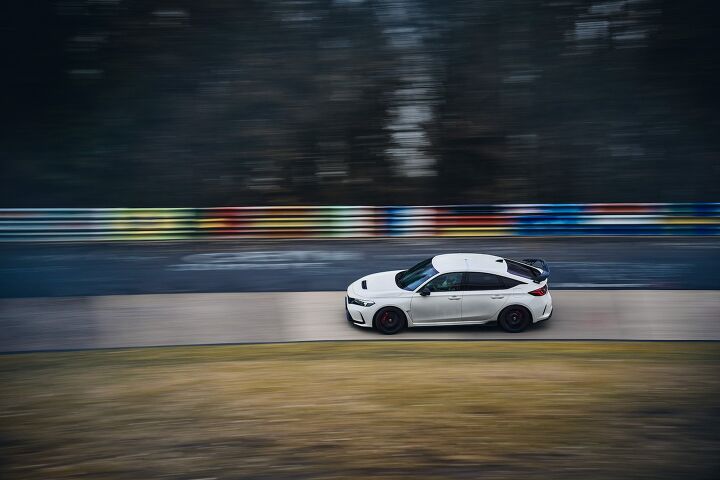You Just Got Beat by a Civic

Yesterday, our man Matt Posky ably wrote about the 2023 Honda Civic Type R and its record-setting lap at the Nürburgring Nordschleife, circling the Green Hell in 7:44.881, enough to best the 2019 Renault Mégane R.S. Trophy-R by over half a second.
This got us thinkin’: with a time like that, what other cars did it beat?
Now, to be sure, there is some merit to the notion that it’s pointless for manufacturers to chase lap times around an arbitrarily selected ribbon of tarmac in the German countryside. With 12.9 miles, 154 corners, and a host of surface changes, it only takes a split-second of inattention to dramatically affect lap times. Nevertheless, measures of a car’s sporting prowess are often arbitrary – look at the quarter mile, for instance, and even the ubiquitous horsepower unit itself is rooted in a very random series of events.
Check out this video to see what we mean.
Here is a sampling of vehicles throughout the years which set official Nürburgring Nordschleife lap times which were slower than the 7:44.881 touted by Honda. Some of the times may be for minorly different track lengths thanks to variations over the years but still make for a fun comparison.
7:46 - Lamborghini Gallardo LP570-4 Superleggera, 2007
7:46.70 - Porsche 718 Cayman S, 2016
7:49 - Chevrolet Corvette C6 Z06, 2007
7:52 - Aston Martin V12 Vantage S, 2014
7:52.17 - Toyota GR Supra, 2019
7:58 - BMW M2, 2015
8:14 - Range Rover Sport SVR, 2014
8:17 - Porsche Cayman S, 2009
8:18 - Ferrari 355, 1997
16:01 - Trabant P50, 1960
Progress, eh? And, in case you missed it, the record-setting Civic Type R was fitted with Michelin Pilot Sport Cup 2 Connect tires, rubber jointly developed with Michelin using know-how amassed through the development of the Michelin Pilot Sport 4 S. It is the latter which is standard kit on the R, though the ones used in the record are available through Honda dealers.
By the way, a Porsche 919 Hybrid Evo turned the trick in 5:19.546 in June 2018 with driver Timo Bernhard behind the wheel. Back in the (almost) real world, Stuttgart sent their Mercedes-AMG One around the place in 6:35.183 on the 20,832 meter lap, the same distance as the Honda.
[Image: Honda]
Become a TTAC insider. Get the latest news, features, TTAC takes, and everything else that gets to the truth about cars first by subscribing to our newsletter.

Matthew buys, sells, fixes, & races cars. As a human index of auto & auction knowledge, he is fond of making money and offering loud opinions.
More by Matthew Guy
Latest Car Reviews
Read moreLatest Product Reviews
Read moreRecent Comments
- 28-Cars-Later "elections"
- Tassos Good job, Senile, Corrupt Idiot-in-Chief.And when Inflation doubles again under your failed watch, LIE again that it was .. 9% when you took office, while THE REAL inflation then was less than 2%!Disgusting imbecile....
- Wjtinfwb Glad to see Toyota hanging in there with sedans. It's a bit clunky looking but no worse than a new BMW 7-series at 1/3 the price. More power would be nice but Toyota is married to the Hybrid/4-cylinder configuration. As this package gets refined I expect it will be come the norm.
- Wolfwagen The last couple of foreign vehicle manufacturers that tried breaking into the U.S. Mainstream Vehicle Market had a very hard time and 1. Couldn't get past the EPA regulation side (Mahindra) or 2. had a substandard product (Vinfast).
- Midori Mayari I live in a South American country where that is already the case; Chinese brands essentially own the EV market here, and other companies seem unable to crack it even when they offer deep enough discounts that their offerings become cheaper than the Chinese ones (as Renault found when it discounted its cheapest EV to be about 15% cheaper than the BYD Seagull/Dolphin Mini and it still sold almost nothing).What's more, the arrival of the Chinese EVs seem to have turbocharged the EV transition; we went from less than 1% monthly EV market share to about 5% in the span of a year, and it's still growing. And if — as predicted — Chinese EV makers lower their production costs to be lower than those of regular ICE cars in the next few years, they could undercut equivalent ICE car prices with EVs and take most of the car market by storm. After all, a pretty sizeable number of car owners here have a garage where they could charge, and with local fuel and electricity prices charging at home reduces fuel costs by over 80% compared with an ICE car.

































Comments
Join the conversation
Thanks, Captain Obvious, for pointing out that 2023 models have way more performance than the same models 20 years ago. WHy don't you tell us how many SERIOUS 2023 SPORTS or GT Cars did that silly Civic Beat? I will help you out. NONE.
Lol, I can't speak for the writer. Maybe they wrote the story figuring the reader would have some context.